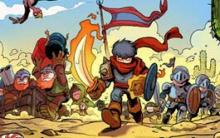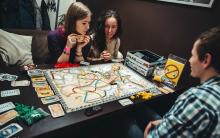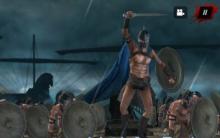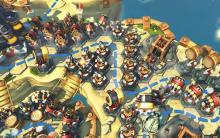Completed by: Vakhonina Valeria, Serin Lana, grade 5B. MBOU SOSH village Toora-Khem Head: Tatiana Yurievna Korobeinikova. Mathematics project on the topic: Mathematical puzzles and games.
Aims and Objectives: To find out what math games and puzzles are. Explore different types of math games and puzzles on your own. Find out what math games are for, are they useful?
1) Puzzles. 2) Puzzles. 3) Games. 4) Tangram. 5) Conclusion. 6) Used literature. 7) Epilogue. Table of contents.
How to solve puzzles
Try to solve it yourself: rebus 1.
Try to solve it yourself: rebus 2.
Try to solve it yourself: rebus 3.
1) Remove 5 sticks so that after that there are 3 of the same squares. puzzle
2) Remove 2 sticks so that 4 of the same squares remain. puzzle
3) Remove 4 sticks so that you get 5 squares. The squares may not be the same. puzzle
Rules of the game: The teacher writes several examples on the blackboard in a column. Three guys stand with their backs to the board. The teacher points to one example. The whole class silently solves it. Whoever has decided raises his hand. One of those who decided is invited to pronounce the answer loudly. Those standing at the blackboard turn to face her and try to find an example with the named answer as soon as possible. Whoever does it first is awarded one point. the game
Let's play! Calculate: 45 + 35 180 - 80 32: 2 18 + 31 150: 3
T Angram. Tangram is an old oriental puzzle made of figures obtained by cutting a square into 7 parts in a special way: 2 large triangles, one medium, 2 small triangles, a square and a parallelogram.
As a result of folding these parts together, flat figures are obtained, the outlines of which resemble all kinds of objects, from humans, animals to tools and household items. All the details of the tangram must be used and they must not overlap. You are given a drawing and you must determine where which figure is located. It is difficult, it takes time to find a solution. T Angram.
Decide the tangrams for yourself
Conclusion. We have studied: the mathematical game Tangram, games with matches, puzzles, a game with numbers. We concluded that math games develop logic and attention. Tangram is a puzzle, constructor, trainer for the brain. He teaches to think logically. Any puzzle will help you calm down, remove negative emotions. After such a game, the child will be much calmer and more balanced.
Fun arithmetic. Amenitsky N.N. Publishing house "Prosveshchenie", 2008 Puzzles, charades, rebuses in the classroom and after school hours. Agapova I.A., Davydova M.A. Publishing house "Uchitel", 2009 Internet resources. Used Books.
We hope everyone really enjoyed it and you fell in love with math even more. In mathematics, there are many more fun and interesting games on earth. This concludes our project for now, but in the future we will continue it and find many more interesting games. Epilogue.
Thank you for the attention! Goodbye!
Math games and puzzles are very popular, as are all games. And the more difficult game is not always the more interesting. Often millions of people play the simplest games with an unquenchable interest; it is they who go down in the history of mathematics and glorify their creators. Math games and puzzles are very popular, as are all games. And the more difficult game is not always the more interesting. Often millions of people play the simplest games with an unquenchable interest; it is they who go down in the history of mathematics and glorify their creators.
Puzzles are closest to mathematics, but many puzzles were formed from games that once existed. Most of these foundational games were invented by ancient Greek mathematicians. Puzzles are closest to mathematics, but many puzzles were formed from games that once existed. Most of these foundational games were invented by ancient Greek mathematicians.

GAMES The simplest mathematical games are often used as problems in which you need to find a winning strategy. Sometimes tasks are very simple when they are solved by well-known methods. The simplest mathematical games are often used as problems in which you need to find a winning strategy. Sometimes tasks are very simple when they are solved by well-known methods.

Tic-tac-toe Tic-tac-toe is a logic game between two opponents on a square field of 3 by 3 cells or larger (up to an "endless field"). One of the players plays with “crosses”, the other with “noughts”. Tic-tac-toe is a logic game between two opponents on a square field of 3x3 cells or larger (up to an "endless field"). One of the players plays with “crosses”, the other with “noughts”.

Currently, many algorithms for this game have been invented, based primarily on enumerating various options. There are the simplest techniques of this game that players use, but attentiveness is most often decisive. Currently, many algorithms for this game have been invented, based primarily on enumerating various options. There are the simplest techniques of this game that players use, but attentiveness is most often decisive.


Renju is a sports board logic game. Invented in China, the most widespread in Japan, China, South Korea. Its old versions are also known as "gomoku", which means "five stones". Renju is a sports board logic game. Invented in China, the most widespread in Japan, China, South Korea. Its old versions are also known as "gomoku", which means "five stones".

BAT game and other games There are several games in which two players, guided by certain rules, take turns taking out a certain number of chips from one or several piles - the one who takes the last chip wins. There are several games in which two players, guided by certain rules, take turns taking out a certain number of chips from one or several piles - the one who takes the last chip wins.

Such games include Him. There is an arbitrary number of piles of chips, and the players take turns choosing one pile and taking out any number of chips from it (but at least one is required). Such games include Him. There is an arbitrary number of piles of chips, and the players take turns choosing one pile and taking out any number of chips from it (but at least one is required).

Bashe is a mathematical game in which two players take turns taking out a limited number of N items from a pile. The loser is the one who has nothing to take. Bashe is a mathematical game in which two players take turns taking out a limited number of N items from a pile. The loser is the one who has nothing to take. The player's math game The player's math game The classic game means N = 15 and taking at least 1 and no more than 3 objects at a time. The strategy in this case is to supplement the opponent's moves to 4. Also, the game Bashe can be called a generalized game in which you can take from 1 to M objects. The classic game involves N = 15 and taking at least 1 and no more than 3 items at a time. The strategy in this case is to supplement the opponent's moves to 4. Also, the game Bashe can be called a generalized game in which you can take from 1 to M objects. Named after the French poet and mathematician Basche de Meziriac. Named after the French poet and mathematician Bashe de Meziriac. Bashe de Meziriac Bashe de Meziriac

Starry nim. It is quite simple, but the strategy is not immediately visible in it. Play this game on a star-shaped figure. Place one chip on each of the nine points of the star. Players A and B make moves in turn, removing either one or two pieces connected by a straight line at each move. The one who removes the last chip wins. It is quite simple, but the strategy is not immediately visible in it. Play this game on a star-shaped figure. Place one chip on each of the nine points of the star. Players A and B make moves in turn, removing either one or two pieces connected by a straight line at each move. The one who removes the last chip wins.


PUZZLES Mathematical puzzles are very different: rotational (Rubik's cube), Magic rings, Games with a hole (tags), lattice and many others. Mathematical puzzles are very different: rotational (Rubik's cube), Magic rings, Games with a hole (tags), lattice and many others.

"Rubik's Cube" The most famous puzzle of our time - the Rubik's cube - began its triumphant march around the world since 1978, when mathematicians were first introduced to it at the International Mathematical Congress in Helsinki. The most famous puzzle of our time, the Rubik's cube, began its triumphant march around the world since 1978, when mathematicians were first introduced to it at the International Mathematical Congress in Helsinki.



Rubik's Cube belongs to rotational puzzles, a distinctive feature of which is that it is as easy as shelling pears to confuse them, but not everyone is able to quickly solve them. Rubik's Cube belongs to rotational puzzles, a distinctive feature of which is that it is as easy as shelling pears to confuse them, but not everyone is able to quickly solve them.


When assembling, it is too difficult to cover the whole picture at once, it is more convenient for us to advance methodically, step by step, first installing one piece, adjusting the second to it, etc. step, first setting one piece, adjusting the second to it, etc.

Games with a hole Before the invention of the Rubik's cube, for many people acquaintance with puzzles began with tags - this is how the well-known game 15 is often called.

Fifteen Fifteen marks begin the history of games with a hole - puzzles in which the pieces move around the playing field due to the fact that one of the places on the field is free. The tag has a variety of relatives who form a whole section of these puzzles. The history of games with a hole begins with tags - puzzles in which the pieces move around the playing field due to the fact that one of the places on the field is free. The tag has a variety of relatives who form a whole section of these puzzles.


From 1891 until his death, Samuel Loyd believed that he had invented the puzzle. However, there is evidence that he was not involved in the creation of the "tags". From 1891 until his death, Samuel Loyd believed that he had invented the puzzle. However, there is evidence that he was not involved in the creation of the "tags".

Samuel Loyd Samuel Loyd (January 31, 1841), Philadelphia April 10, 1911, New York) is an American chess player, chess composer, and puzzle writer. January 31, 1841 Philadelphia April 10, 1911 New York American chess player chess puzzle composer
 The game "Transferring cards" At the moment after the cards were laid out in two piles for the first time, then again folded into one pile, as indicated in the problem statement, the card with the intended number is among the lower eight. These 8 cards are divided equally between the two piles the next time they are unfolded. This means that after the cards are collected in one pile for the second time, the card with the intended number will be among the four lower ones. The third time it will be among the two bottom cards, and, finally, after the fourth unfolding, the card will be the bottom one in one of the piles. At the moment after the cards were laid out in two piles for the first time, then again folded into one pile, as indicated in the problem statement, the card with the intended number is among the lower eight. These 8 cards are divided equally between the two piles the next time they are unfolded. This means that after the cards are collected in one pile for the second time, the card with the intended number will be among the four lower ones. The third time it will be among the two bottom cards, and, finally, after the fourth unfolding, the card will be the bottom one in one of the piles.
The game "Transferring cards" At the moment after the cards were laid out in two piles for the first time, then again folded into one pile, as indicated in the problem statement, the card with the intended number is among the lower eight. These 8 cards are divided equally between the two piles the next time they are unfolded. This means that after the cards are collected in one pile for the second time, the card with the intended number will be among the four lower ones. The third time it will be among the two bottom cards, and, finally, after the fourth unfolding, the card will be the bottom one in one of the piles. At the moment after the cards were laid out in two piles for the first time, then again folded into one pile, as indicated in the problem statement, the card with the intended number is among the lower eight. These 8 cards are divided equally between the two piles the next time they are unfolded. This means that after the cards are collected in one pile for the second time, the card with the intended number will be among the four lower ones. The third time it will be among the two bottom cards, and, finally, after the fourth unfolding, the card will be the bottom one in one of the piles.

Geometric puzzle "Pass a coin" The diameter of a 5-tick coin is 19 mm, of a 5-tier coin - 25 mm. I bend the paper so that the round hole extends into a narrow slot. The length of the slot will be approximately equal to half the circumference of a 5-kopeck coin: (19 * 3.14) / 2 = 29.83 mm. This is more than 25 mm. A 5-ruble coin passes through it. The diameter of a 5-tick coin is 19 mm, a 5-tier coin - 25 mm. I bend the paper so that the round hole extends into a narrow slot. The length of the slot will be approximately equal to half the circumference of a 5-kopeck coin: (19 * 3.14) / 2 = 29.83 mm. This is more than 25 mm. A 5-ruble coin passes through it.

Conclusion Conclusion Calculating a variant is an exciting and rewarding activity. The great mathematician Leibniz was right: "People show the most inventiveness in games, which means that mathematical games deserve attention not only in themselves, but also due to the fact that they develop resourcefulness." Calculating an option is an exciting and useful activity. The great mathematician Leibniz was right: "People show the most inventiveness in games, which means that mathematical games deserve attention not only in themselves, but also due to the fact that they develop resourcefulness."

Site addresses htm Lethwaite game htm Lethwaite game htm noughts and crosses noughts and crosses htm starry nim htm starry nim


To use the preview of presentations, create yourself a Google account (account) and log into it: https://accounts.google.com
Slide captions:
mathematical puzzles GKOU boarding school in Parkovy Zemtsova Irina Anatolyevna
To drive ships, To take off into the sky, You need to know a lot, You need to be able to do a lot. To become a doctor, a sailor Or a pilot, You must first of all know Mathematics.
Do you know the numbers? Round I
The elephant has wings, but their number is ... 4 3 2 5 1 0 3 7 4 1
This number is often found in fairy tales 4 3 2 5 1 0 3 7 4 1
That figure, kids, consists of a trunk and a pitiful branch. 4 3 2 5 1 0 3 7 4 1
How many musicians are there in the quartet? 4 3 2 5 1 0 3 7 4 1
Find the extra number 1 2 3 4 1 7 8 5
01 02 03 04 1 2 3 4
How old can you ride a bike on the highway? 12 years 10 years 14 years 8 years 1 2 3 4
II round Unusual problems
Chickens and dogs walked in the yard. The girl counted their paws. It turned out ten. How many chickens and how many dogs could there be?
A rooster on one leg weighs 3kg. And how much will he weigh if he stands on 2 legs?
The dump truck was driving to the village. Three cars were driving towards him. How many cars were driving to the village?
If you saw off one corner of the table, how many corners are left?
Round III geometric shapes
Which shape has no definition? 1 2 3 4 angle ray line segment point
A part of a straight line bounded by two points? 1 2 3 4 angle ray line segment point
What geometric shape is needed to punish children? 1 2 3 4 angle ray line segment point
What figure means “table” in Latin? 1 2 3 4
Which figure is translated from Greek as “pinecone”? 1 2 3 4
Blitz Tour
1. Fourth month. 2. Result of subtraction. 3. The sum of the lengths of the sides of the rectangle. 4. How many fingers are there in 10 hands? 5. The largest two-digit number. 6. What is the name of the line measuring device ?. 7. How many millimeters are in 1 meter? 8. A quadrilateral in which all sides are equal 9. What numbers do pilots write in the sky? 10.Numbers I, V, X are called (April) (difference) (Perimeter) (50) (99) (ruler) (1000 mm) (square) (eights) (Roman)
On the subject: methodological developments, presentations and notes
Lesson - business game "Working with Power Point Presentation Package". During the lesson, the repetition of the material "spreadsheets" with the use of CMMs, the repetition of ...
There are 35 students in the class. 20 of them are engaged in a mathematical circle, 11 - in a biological one, and 10 are not engaged in anything. How many guys are engaged in both mathematics and biology? (6 people) How many ways can you arrange 4 checkers on a drawn board so that no two of them are in the same row or in the same column? (A) 64; (B) 28; (C) 16; (D) 8; (E) 4. In the addition example: * + * + ?? =? ? ? different figures replace different numbers. What number does the asterisk replace? (A) 9; (B) 8; (C) 7; (D) 6; (E) 5; Teams A, B, C, D and E participated in the handball tournament. Each team played each one exactly once. For a victory in the game, 2 points are given, for a draw 1, for a defeat - 0. At the same time, team B, which took second place, scored more points than C, D and E together. It follows that (A) A took first place; (B) A beat B; (C) B beats C; (D) A and B tied; (E) such a result is not possible.
Math Week 2014
Math Puzzles
Mathematics teacher MBOU secondary school № 18 p. Haragun 2014

1. The result of addition. 2. How many numbers do you know? 3. The smallest three-digit number. 4. One hundredth of the number. 5. A device for measuring angles. 6. How many centimeters are there in a meter? 7. How many seconds are in a minute? 8. Result of division. 9. How many years are in one century? 10. The smallest prime number. 11. How many zeros are there in the number "million"? 12. The magnitude of the right angle. 13. When is the product equal to zero? 14. What is more than 2 m or 201 cm? 15. What is less than 200 or 0.5?
Warm up


Blitz Quiz
1. Seven brothers have one sister. How many children are there? 2. Which is lighter: a kilogram of cotton wool or a kilogram of iron? 3.Two sons and two fathers ate three eggs. How many eggs did each one eat? 4. A pair of horses ran 40 km. How many kilometers did each horse run? 5. What used to be called "broken numbers" in Russia? 6. What does each word, plant, and equation have? 7. In the fairy tale "The Little Humpbacked Horse" we meet the following words: "The darkness is coming to the people! Well, neither exit nor entrance! " How many people were there?

Divide a shape into two equal parts
How many triangles are there in the drawing?


1. A figure consisting of two rays emanating from one point. 2. A figure consisting of three points that do not lie on one straight line and three segments. 3. The part of a straight line lying between two points. 4. Unit of length. 5. Tool for measuring the length of the segment. 6. The main figure. 7. Tool for measuring angles. 8. What does the word "arithmetic" mean? 9. A line that has neither beginning nor end.











Outdoor sports senior group
Card file of didactic games "preparatory group" Didactic games for children 5 7 years old
The value of playing cards in fortune-telling for predicting the future
Shrovetide: indoor and outdoor games for all ages
Heroes Tactics: PvP Strategy